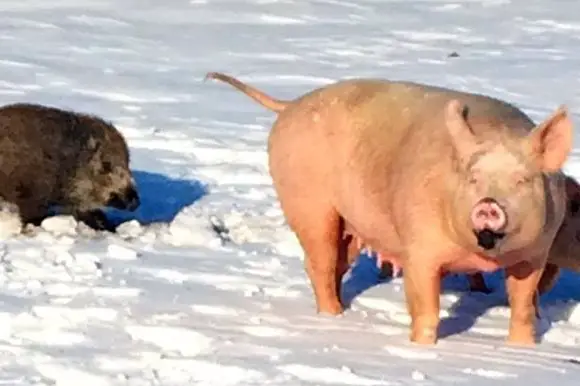Animals like pigs can have a hard time thriving under severe weather conditions. How can we help pigs when the season turns harsh? There are a few ways to keep your pig warm in the middle of the freezing cold.
Depending on your style of raising your pigs, whether it is indoor or outdoor, we will provide tips for both situations for you.
1. Why you should keep pigs indoors during winter
The best way to help your pig is obviously by keeping them indoors. However, not all owners can afford keeping pigs inside especially if there are many pigs which is why we will provide other tips related to outdoor life in winter.
For indoor pigs, it will be easier to monitor what your pig needs and decide what the next steps are that you can take for your pig.
Being indoors guarantees that they can stay dry and less at risk with pneumonia.
They will also feel mentally stimulated to be indoors since being inside a house will give them more opportunities to socialize, interact or move freely without being bothered by the cold weather.
When kept outdoors during winter, pigs become less active and are unable to maintain their regular activities including their diet.
It is healthier for pigs to be kept indoors as much as possible and it is easy to house train pigs!
Read: “Can Pigs be House Trained?” to learn more.
2. What kind of bedding can help a pig in winter
Owners are suggested to use miscanthus straws, wood shavings and coarse sawdust. We can also use a bunch of shredded paper. Using these materials will help keep them warm.
For outdoor pigs, giving them new straws for their bedding can help refresh them and make them feel warm the moment they use the new bedding.
It can also help if you provide more than necessary because the more straws there are, the more warmth will be generated.
The same can be applied for indoor pigs, if they are using a specific type of bedding. Thick layers of bedding help sustain heat that can keep them warm even just a little.
3. How you should handle blankets for pigs during winter
Providing blankets may seem very easy, but there are still some things we need to look out for. If your pig is resisting the blanket, remove it. If they are not comfortable, it defeats the purpose of helping them in the first place!
An easy way to make them feel comfortable with blankets is to not wrap them in it that can possibly lead to suffocation. Always leave some space for them to slip through when they want to get out of the blanket.
You can opt to provide old and unused blankets instead of throwing it away to help you save and it will definitely help your pigs stay warm.
Both outdoor and indoor pigs could use blankets to stay warm. Any type of blanket can really be helpful, but providing them with thick and soft blankets will be the best option.
Just because they are animals doesn’t mean they do not deserve the luxuries of winter protection.
Some pigs may thrive better under harsh weather conditions like winters but not all pigs can tolerate as good as the other breeds.
4. Why you should make sweaters for pigs in winter
You can let them wear worn out toddler clothes that can help keep them warm even just a little bit! You may also knit for them if you feel like it.
This can be optional and situational depending on your pig. Regardless if they are being kept indoors or outdoors, some pigs would appreciate wearing sweaters in order to stay warm.
Some pigs may not like wearing clothes and we advise owners not to force them if the pigs are really refusing.
Even when you do manage to put a sweater on for your pig when they despised it in the first place, it might hinder their locomotive capabilities. Some animals will stop moving unless you remove the unwanted fabric.
But for those who do and are obedient about the sweaters, it may actually be really cute to see them wear cute clothes that can keep them warm in winter.
Make sure you get them changed too because dirty clothes can be bad for a pig’s health. It may keep them warm, but it will be pointless if the sweater is dirty and can make them sick in the end.
5. How much food can help pigs stay warm in winter
Average pigs consume 1 to 3 kilos of food on a daily basis, increasing food intake from 3 kilos to 4 or 5 kilos could contribute to how much their bodies can produce natural body heat.
Pigs that eat more can produce more energy to create body heat. Indoor or outdoor pigs can do this method but owners must ensure that the pigs also have a way to burn off excess fat.
Some pigs can become obese easily despite their natural or average weight gain. Obesity is not good compared to normal body fat!
It is actually the top most common issue among pet pigs and they become less active in winter which is why pigs cannot get rid of excess body fat they gained during winter.
6. What kind of exercise can help pigs in winter
This part is related to tip number five. If the snow is not severe and your pig wants to go out, you can let them play outside and run in the snow for a short period of time.
Making time for exercises is important in winter as it helps them heat up.
Pigs may refuse moving around due to the cold but if you find a nice place for them to run around in, they might be able to ignore the cold even just for a while and manage to do some exercises which is helpful.
Moving around will make you feel the heat instead of curling up in a corner due to the cold. It also helps prevent obesity as mentioned above.
Doing this will also help keep them entertained. Sometimes, pigs in winter can be bored and end up depressed when they have no choice but to stay indoors most of the time.
By completing specific activities, they can feel energetic which will also somehow condition them into forgetting or ignoring the cold even just a bit.

7. How natural body heat can help pigs stay warm in winter
Natural body heat is one of the easiest ways to stay warm in winter. If you raise more than one pig and keep them outdoors, you can prepare a large bedding for all of them to share.
When they cuddle up next to each other, their bodies contain body heat that will be shared to the animal nearest to them.
This is how most social animals stay warm in winter, they do it by sticking together.
Pigs are social animals and will naturally stick together during hard times in their lives. Mother pigs can also be often seen stacking up straws for her offspring even when they are already fully grown to keep them warm.
8. How to trap heat inside a pig’s living enclosure in winter
For indoor pigs, always shut the door and the windows to keep the wind from reaching your home.
Outdoor pigs that live in pens should have a secured pen with little to no holes that will allow the heat to escape.
Make sure that the ceiling is high enough for them to still breathe properly despite the secluded room style.
Sturdy pens should be built in order to be prepared for winter.
9. Why you should keep pig pens dry during winter
Prevent water from entering a pig’s living premises by ensuring the entrance is completely sealed or has an elevated design to be higher than the ground level where water will be contained overtime.
Whether the pigs are indoors or outdoors, the entire living space must remain dry. Snow from winter will always turn into cold water the moment it reaches the floor.
Water should not be able to reach the living areas which is why pens must be properly built to keep water out that will contribute to the cold. Dry living areas will keep pigs dry and warm too.
10. Why you should consider installing a heater for winter season
Installing a heater can be really helpful and will greatly reduce the worries of pig owners especially the ones who keep their pigs outdoors. It is one of the most effective ways of keeping your pig warm in winter.
Barn heaters or simple room heaters could cost around $300 and range higher depending on your store. Prices may also differ completely depending on your country!
Though this option is costly, it is worth it because it can provide the utmost comfort for outdoor pigs struggling in the cold.
Related Questions
- Do pigs smell?
No, pigs naturally do not have an odor. This is because they have little sweat glands that can barely allow them to sweat. The only smell coming from pigs is brought by their living conditions and environment.
Pigs are not picky animals, they are opportunistic and will choose what’s always available to them.
They are clean animals and will stay clean if they had the luxury. However, most pigs only have access to mud and dirty environment which develops into a mixed scent that many people despise.
In fact, pigs would prefer water over mud anytime.
It’s only that pigs are always kept under poor conditions that they begin to pick up smells that do not really naturally belong to them.
Read: “Do Mini Pigs Smell?” for a related topic.
- Do pigs get sick easily?
Yes, pigs CAN get sick easily.
It is actually situational. Some breeds can be resistant to specific sicknesses but on an average, most pigs can get sick easily by consuming meat, being exposed to severe weather conditions and other unhealthy lifestyle.
Pigs can become very healthy to the point of almost never getting sick in their lifespan of 15 to 20 years.
As long as the pig is raised properly with a balanced and nutritious diet, given with adequate love and care, pigs will be healthy and will not be prone to sicknesses.
A pig’s health can always depend on their environment or living conditions.
Read: “How to Care for Pigs?” for more details.
- Is it expensive to raise pigs?
Depending on your preferred setup of raising pigs, the prices may differ.
Indoor Pet Pigs — around $300 (excluding the price of pig purchase)
Outdoor Pet Pigs — around $800 (excluding the price of pig purchase)
Farm / Livestock Pigs — around $800 to $1200 (excluding the price of the pig purchase)
Different places, shops, brands, products and conditions can also affect prices. However, in conclusion, raising indoor pet pigs costs less than outdoor pet pigs and farm pigs.
For a detailed answer, you can read: “How Much Does it Cost to Raise a Pig?” full guide.
